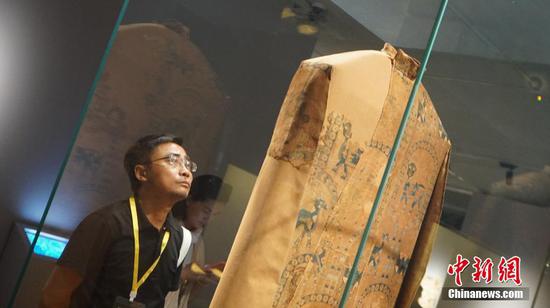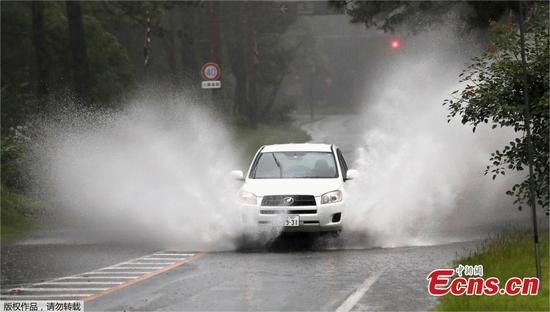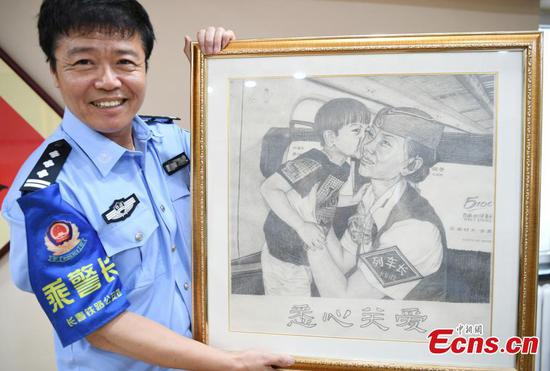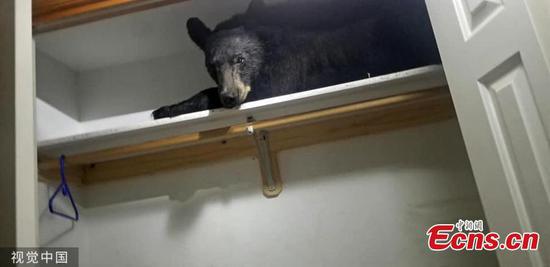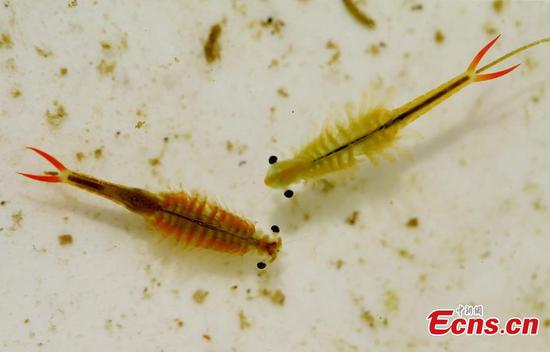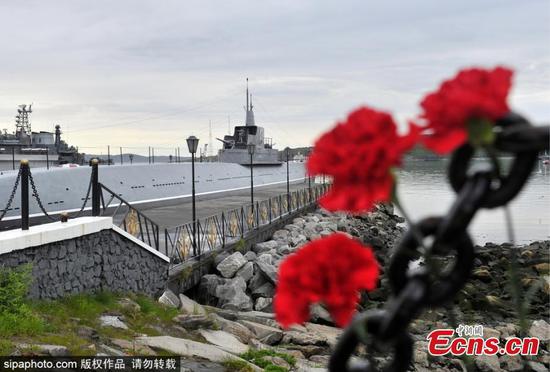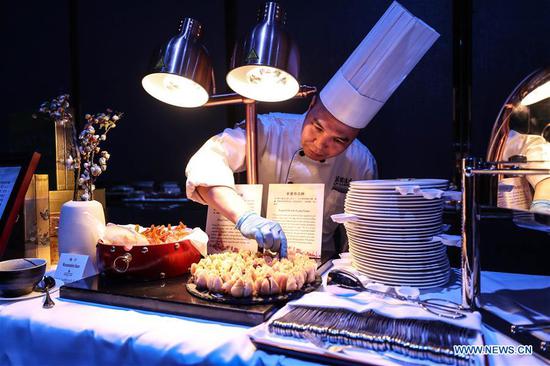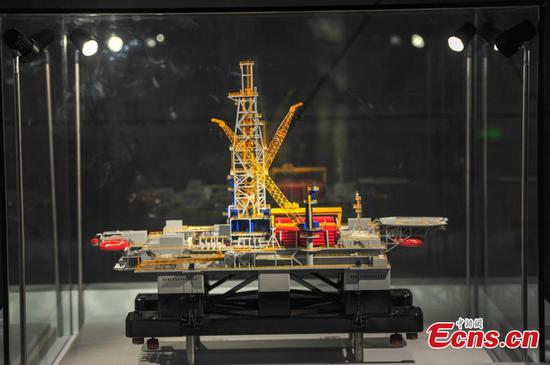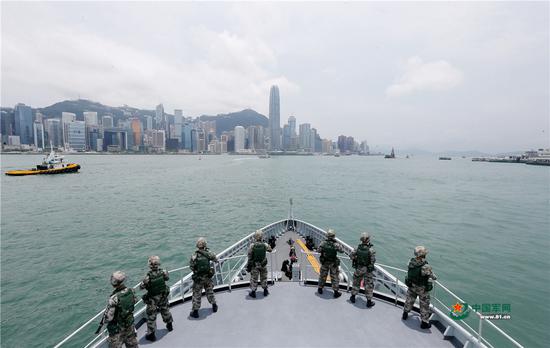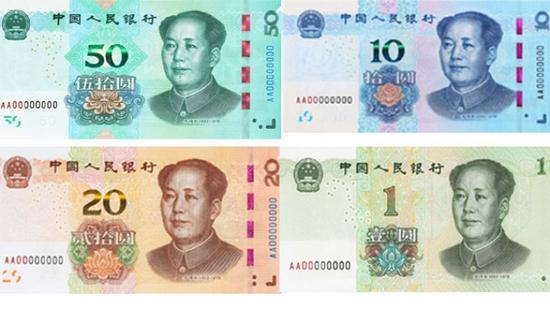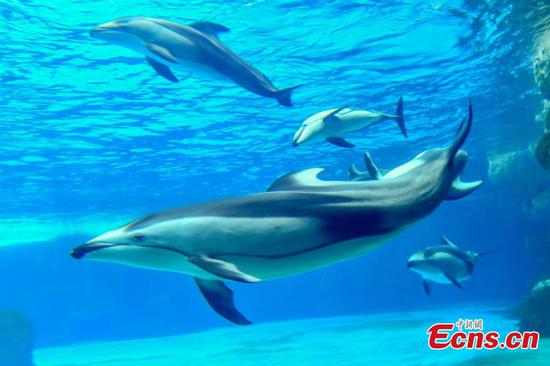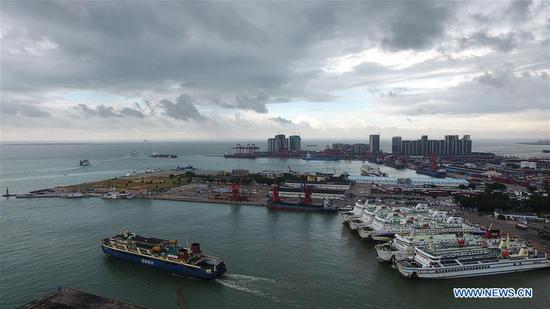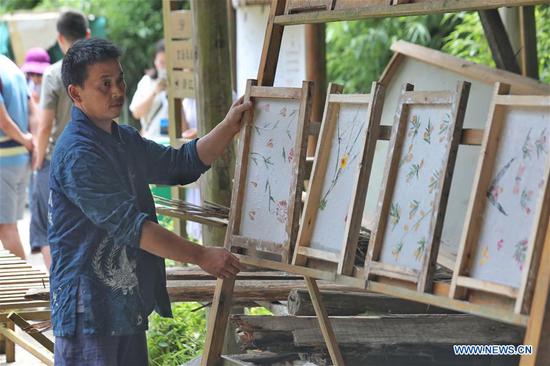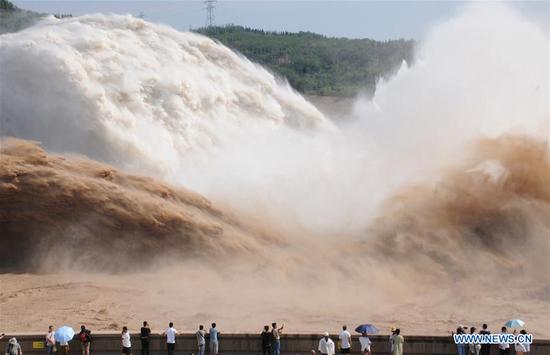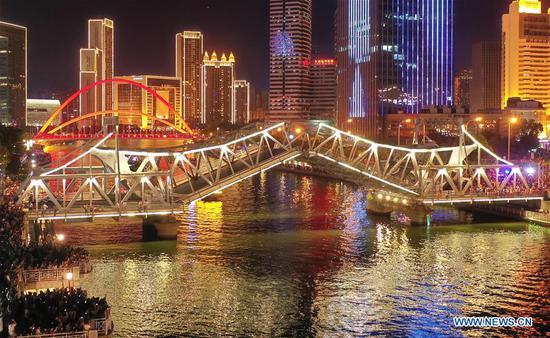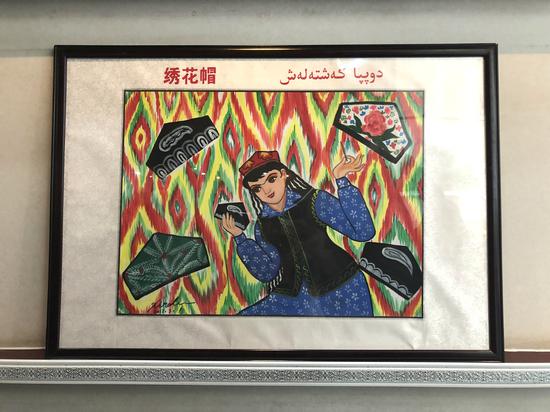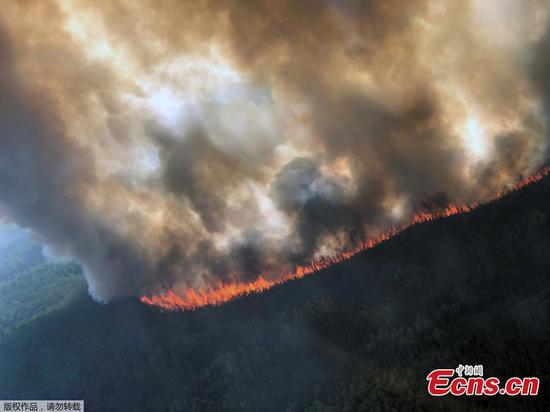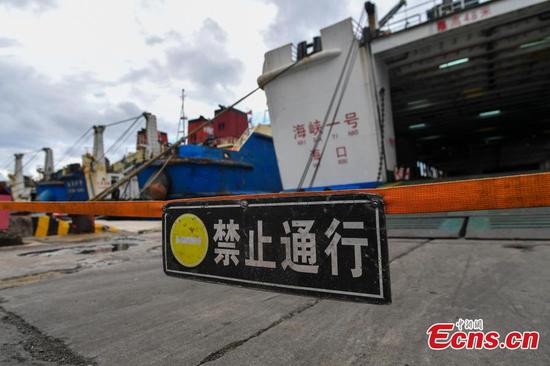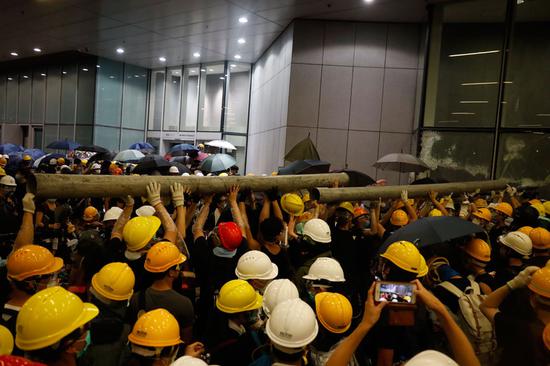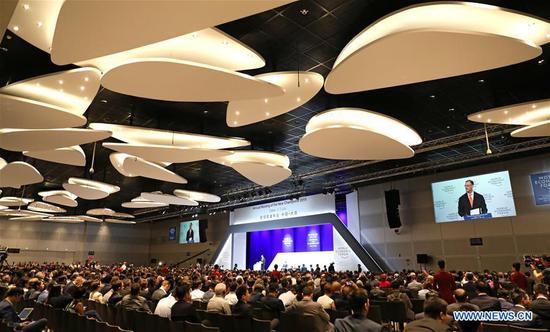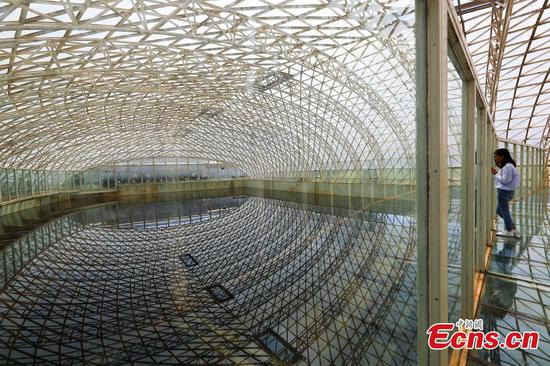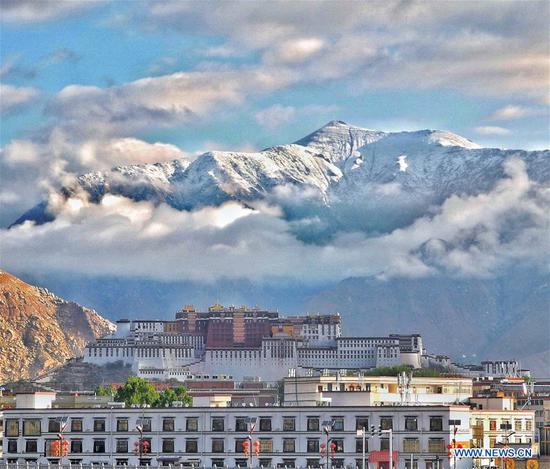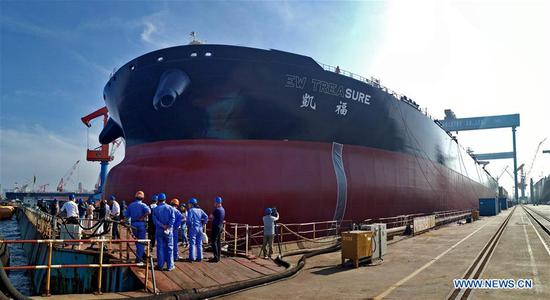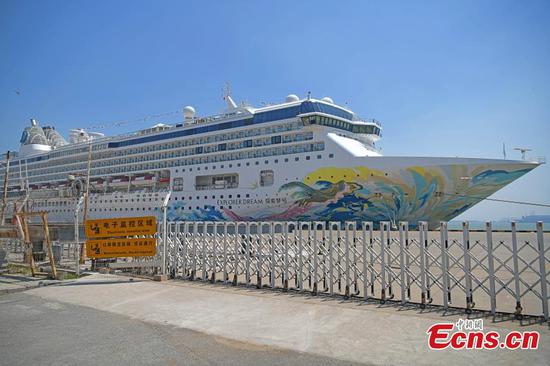
Workers dismantle steelmaking equipment at a factory in Tangshan, Hebei province, that has ceased production to cut overcapacity. (YANG SHIYAO/XINHUA)
Technology is helping Tangshan, Hebei province, foster emerging sectors and embrace the opportunities presented by 'intelligent production'. Wang Jinye, Wang Hongfeng and Li Laifang report for Xinhua.
With the head sheaves whirling on top of the derrick, the century-old No 1 pit at Kailuan colliery still lifts coal from deep underground. However, the icon of the old industrial city of Tangshan, Hebei province, is now a tourist site.
The shaft, which began operations in 1881 and is the earliest of its type in China, is located at the Kailuan National Mining Park, a symbol of modern industrial heritage that includes the country's first standard gauge railway track.
Culture and tourism are just part of the efforts being made amid the city's diversified development program.
Tangshan, to the east of Beijing, is one of China's oldest industrial bases, featuring the coal, steel and chemical industries. As the country deepens supply-side structural reform in search of high-quality growth, the coastal city is working to upgrade its traditional industries, cut pollution and foster emerging sectors through innovation, investment and integrated regional development.
Structural transformation
In the past seven decades, the Kailuan colliery has produced 1.67 billion metric tons of raw coal and 408 million tons of clean coal.
In recent years, the mine has been facing woefully inadequate resource reserves. "The transformation is pressing," said Zhang Yuliang, a senior executive with Kailuan Group.
In 2017, to promote structural transformation, the company decided to optimize and strengthen its backbone industries - coal, coal chemical and modern services - via advanced equipment and technology, and develop strategic emerging industries, such as new energy and new materials.
"The corporate research team has been developing new coal chemical products to push the industry chain toward the high-end," Zhang said.
The company has piloted intelligent mining with one unmanned working face, conducted mixed ownership reform of its subsidiaries, and gone global with a mine-related service business in India and Kyrgyzstan.
Last year, the company's revenue hit 76 billion yuan ($11 billion), with the coal chemical sector accounting for nearly 25 percent of the total. Meanwhile, profit soared by 146 percent year-on-year, while the logistics services generated revenue of more than 40 billion yuan.
As China made cutting overcapacity one of the major tasks in supply-side structural reform in late 2015, the provincial authorities ordered Kailuan to cut coal capacity by 18.55 million tons from 2016 to 2020 and reduce the workforce by 25,000 people.
"Kailuan encountered difficulties in the first two years of the reform. My salary was sometimes delayed," said Li Wei, who joined the company after graduating in automation from Hebei University in 2008 and is now in charge of the electrical and mechanical department.
"Today's Kailuan is quite different from the past, when my grandfather and father worked here. What it needs is not more labor, but technological innovation."
Intelligent production has also been promoted by HBIS Group Tangsteel, a large steel enterprise founded in the city in 1943. Designed to produce 1.8 million tons of finished products a year, the high-strength automobile plate factory has become a landmark project to upgrade products via intelligent manufacturing.
"We have made big efforts to push technological progress and the upgrading of products through investment and cooperation with institutes and universities," said Wang Lanyu, chairman of Tangsteel, a subsidiary of Hebei Iron and Steel Group, one of the world's largest steelmakers.
Last year, Tangsteel's output of high-end key products reached 5.7 million tons, accounting for 41 percent of its steel products, and the company made a profit of 2 billion yuan. Sales of steel for automobiles and home appliances jointly accounted for 26 percent of its total steel products.
"Through hard work, Tangsteel has developed from a steel plant that used to produce ordinary construction steel into a large, modern, high-quality steel base for automobiles and home appliances," Wang said.
123Next >>|

Technicians adjust firefighting robots at a production facility in Tangshan last month. Robotics is one of the five emerging industries that will drive the city's economy. MU YU/XINHUA
New growth drivers
With a population of about 8 million, Tangshan is aiming to become a window city for economic cooperation in Northeast Asia, a new-style industrialization base in the Bohai Rim area and an important pivot of China's economic cycle.
In 2017, Tangshan became one of the country's first 12 cities, or economic zones, to act as demonstration areas for industrial transformation and upgrading.
Five emerging industries - including intelligent rail transit, robotics, electronics and intelligent instruments - are becoming new drivers of the city's economy.
Home to CRRC Tangshan, one of China's major high-speed train manufacturers, the city has established an intelligent rail transit industry alliance and an innovation and development center for the rail industry.
The combined annual output value of 56 robot manufacturing companies hit 6 billion yuan last year, or half of the total output value of the Tangshan Hi-tech Industrial Development Zone, according to an official with the State-level facility.
CITIC Heavy Industry Kaicheng Intelligent Equipment, which is located in the zone, aims to become a world-class specialist robotics manufacturing base. To that end, it makes more than 30 different robotic products.
"We invest more than 6.5 percent of our main business revenue in research and development every year to ensure our leading position in technology," said Lu Wentao, the company's general manager.
According to data from the Tangshan Industry and Information Technology Bureau, from January to April the added value of the five emerging sectors jumped by 31.9 percent, 20.7 percentage points higher than average growth in the city.
Chen Jingming, deputy head of the city's development and reform commission, said, "We take key emerging industrial projects as a booster for development."
In the first quarter of this year, Tangshan's GDP registered year-on-year growth of 7.8 percent, the city's highest Q1 rate since 2014.
"Tangshan is in an overlapping period during which traditional industries experience arduous transformation, while emerging industries are being fostered," said Zhang Gui, an expert on the integrated development of the Beijing-Tianjin-Hebei cluster at Hebei University of Technology in the northern port city of Tianjin.
"Technological innovation is the lifeline for the successful transformation of old industrial bases. Tangshan must embrace the new round of industrial revolution backed by the internet, big data and artificial intelligence."
According to the 2019 Global Cities Outlook report by A.T. Kearney, an international consultancy, Tangshan ranks as the world's 77th most-promising city.
The cargo throughput of Tangshan Port reached 637 million tons last year, jumping to third place among the country's coastal ports. In the first five months of this year, the port's throughput grew by 7.1 percent from the same period last year to reach 265 million tons.
As a new area of Tangshan Port, the Caofeidian port zone in Caofeidian district is booming.
It boasts two of the country's seven approved berths that can dock vessels of 400,000 tons. The port zone has 101 berths dealing with ore, coal, crude oil, liquefied natural gas and containers, and has handling capacity of 470 million tons.
With direct maritime trade routes to more than 70 countries and regions, Caofeidian is a new growth center for Tangshan, as well as the Beijing-Tianjin-Hebei cluster. It has attracted significant investment and emerging industries from Beijing under plans to jointly build Caofeidian into a demonstration zone for integrated development.
Last year, the port area saw a logistics trade volume of 100 billion yuan, and the number is expected to double this year. The booming port area aims to become the world's largest logistics center for coal and ore.
|<>|

From black to green
In addition to cutting industrial capacity in sectors such as coal and steel, Tangshan's resource-based companies have been urged to adopt new, advanced methods to cut pollution and attempt to realize green production.
From 2013 to last year, the city slashed nearly 80 million tons in iron and steel production capacity, dismantled and sealed off 147 converters and furnaces, and closed small polluting factories. The number of iron and steel companies in the city has been cut by one-third, from 58 in 2012 to 38 last year.
Over the past two years, in addition to achieving zero discharge of wastewater, Tangsteel has invested 2.7 billion yuan in a number of projects aimed at reducing emissions and saving energy, which has realized ultralow emissions in all production lines. The company also took the initiative in cutting carbon monoxide emissions.
"Tangsteel has been pursuing green transformation to realize green manufacturing," said Wang, the company chairman.
Last year, Tangshan's average density of PM2.5, fine particulate matter that can enter the bloodstream via the lungs, was 60 micrograms per cubic meter, a fall of 9.1 percent from 2017. This year, the city is targeting a 5 percent fall in PM2.5 density.
This month, a greening project, "The Tangshan Sea of Flowers" in Kaiping district, will open to the public as part of the city's efforts to restore the damaged environment and develop tourism.
Nanhu area in the downtown used to be an untreated mined-out area and a fetid garbage dump. After major restoration efforts, it has become a scenic park where visitors are admitted free of charge. Last year, it received 4.8 million visitors.
"We will make Nanhu an attractive and dynamic zone, and an emerging growth point to serve the city's strategic transformation," said Xue Shaojiang, an official with the Tangshan Culture and Tourism Group, a company devoted to the development of the city's tourism sector.
Wang Jianhua, Cao Guochang and Gao Bo contributed to the story.
|<











